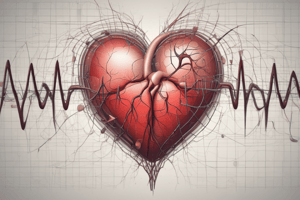Podcast
Questions and Answers
What are the 2 most common causes of Pulseless Electrical Activity? (Select all that apply)
What are the 2 most common causes of Pulseless Electrical Activity? (Select all that apply)
- Hypovolemia and hypoxia (correct)
- Hypovolemia and hyperkalemia
- Hypothermia and hypoxia
- Hypoxia and hyperkalemia
What is the correct dosing regimen of epinephrine to treat PEA or Asystole?
What is the correct dosing regimen of epinephrine to treat PEA or Asystole?
- 300 mg bolus
- 1 mg IV/IO - repeated every 3 to 5 minutes (correct)
- 0.5 mg IV/IO - repeated every 8 to 10 minutes
- 1 mg IV/IO - repeated every 8 to 10 minutes
Pulseless Electrical Activity is defined as:
Pulseless Electrical Activity is defined as:
- No electrical activity present on an ECG
- A perfusing rhythm without spontaneous respirations
- Ventricular Fibrillation
- Any organized rhythm without a pulse (correct)
Possible causes of an isoelectric ECG (flat line) include:
Possible causes of an isoelectric ECG (flat line) include:
Which of the following is not a reason to stop or withhold resuscitative efforts?
Which of the following is not a reason to stop or withhold resuscitative efforts?
Routine insertion of an advanced airway in asystole:
Routine insertion of an advanced airway in asystole:
The first dose of amiodarone for PEA treatment is:
The first dose of amiodarone for PEA treatment is:
Which of the following statements is not true?
Which of the following statements is not true?
Which of the following statements is true?
Which of the following statements is true?
PEA and Asystole are shockable rhythms.
PEA and Asystole are shockable rhythms.
Flashcards
Common PEA causes?
Common PEA causes?
Low blood volume and insufficient oxygen.
Epinephrine dosage for PEA/Asystole?
Epinephrine dosage for PEA/Asystole?
1 mg IV/IO, repeat every 3-5 minutes.
What defines PEA?
What defines PEA?
Organized rhythm on ECG without a palpable pulse.
Advanced airway in asystole?
Advanced airway in asystole?
Signup and view all the flashcards
Amiodarone for PEA?
Amiodarone for PEA?
Signup and view all the flashcards
Are PEA/Asystole shockable?
Are PEA/Asystole shockable?
Signup and view all the flashcards
Can the heart's electrical system be restarted?
Can the heart's electrical system be restarted?
Signup and view all the flashcards
Is it beneficial to defib asystole?
Is it beneficial to defib asystole?
Signup and view all the flashcards
Treatment of PEA is limited to interventions outlined in the algorithm
Treatment of PEA is limited to interventions outlined in the algorithm
Signup and view all the flashcards
Not a reason to stop resuscitation?
Not a reason to stop resuscitation?
Signup and view all the flashcards
Study Notes
Pulseless Electrical Activity (PEA) and Asystole Overview
- PEA is characterized by any organized rhythm without a pulse, displaying QRS complexes that are similar but may vary in rate and regularity.
- Commonly reversible causes of PEA include hypovolemia and hypoxia.
Epinephrine Administration
- The proper dosing regimen for epinephrine in PEA or asystole is 1 mg administered IV/IO, repeated every 3 to 5 minutes.
ECG Interpretation
- An isoelectric ECG (flatline) might result from factors such as loose leads, lack of power to the monitor, or inadequate gain/amplitude settings.
Resuscitation Efforts
- Rigor mortis and clear do-not-attempt-resuscitation (DNAR) status are valid reasons to stop resuscitative efforts.
- Continuous efforts even after 20 minutes without success are grounded in clinical judgment, not strict time limits.
Advanced Airway Management
- In asystole, advanced airway insertion should be considered only if bag-mask ventilation is insufficient, prioritizing ventilation effectiveness over IV/IO access.
Amiodarone Use in PEA
- Amiodarone is not indicated for PEA; its use is reserved for ventricular fibrillation (VF) or pulseless ventricular tachycardia (pVT).
Treatment Protocols for PEA
- Treatment of PEA extends beyond standard algorithm interventions; healthcare providers must actively seek and address underlying causes for successful resuscitation.
Defibrillation in Asystole
- There is no evidence supporting the efficacy of defibrillation for asystole; attempts to shock are discouraged unless distinguishing between fine VF and asystole is necessary.
Rhythm Classification
- PEA and asystole are classified as non-shockable rhythms, which guides treatment approaches and interventions.
Studying That Suits You
Use AI to generate personalized quizzes and flashcards to suit your learning preferences.




